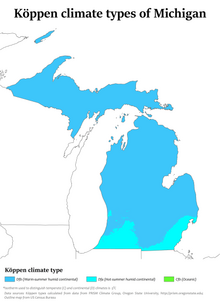This article contains too many or overly lengthy quotations. (May 2022) |

Climate change in Michigan encompasses the effects of climate change, attributed to man-made[1] increases in atmospheric greenhouse gases, in the U.S. state of Michigan.
The United States Environmental Protection Agency states that "Michigan's climate is changing. Most of the state has warmed two to three degrees (F) in the last century. Severe thunderstorms and tornadoes are becoming more frequent, and ice cover on the Great Lakes is forming later or melting sooner. In the coming decades, the state will have more extremely hot days, which may harm public health in urban areas and corn harvests in rural areas".[2]
People have increased the amount of carbon dioxide in the Earth’s atmosphere by 40 percent since the 1700s. This caused the atmosphere to rise in temperature, which allowed for more evaporation, which called for more rain. Heavy storms have increased in number and now exert 31% more precipitation than they did 50 years ago. The increase in heavy rainfall contributes to mass flooding seen within most of the state, especially in the downstate/Detroit area. Flooding allowed land pollutants, such as E. coli, nitrates, and phosphates, to flow into Michigan’s freshwater sources. In 2014, Toledo had to shut down their water supply because bacteria and algae contaminated their water supply. The rising temperatures have resulted in more and more people experiencing heat-related injuries and illnesses, and in some cases, death.[3] Michigan has the MI Healthy Climate Plan, which plans to reach 100% carbon neutrality by 2050. This plan aims to provide good-paying jobs and a healthier, more sustainable environment for Michiganders and avoid the worst impacts of the climate crisis.[4]
The overall effects are expected to be widespread, mixed, and net-negative. A January 2013 'National Climate Assessment' study on the Great Lakes region, led by University of Michigan scholars, stated that climate change would have mixed but net-negative effects in the region by 2050. Specifically, longer growing seasons as well as higher carbon dioxide levels were predicted to increase crop yield but heat waves, droughts, and floods were also forecast to rise. The report predicted declines in ice cover on the Great Lakes that would lengthen commercial shipping season although the regions would also suffer from invasive species as well as damaging algae blooms. The negative scenario described in the study used modeling with a 3.8 to 4.9 °F (2.1 to 2.7 °C) range for 2000 to 2050 warming versus the 1 °F (0.56 °C) of historical warming for 1950 to 2000.[5]
- ^ "Chapter 3: Human Influence on the Climate System".
- ^ Office of Drinking Water & Municipal Assistance. "Groundwater Statistics" (PDF). Michigan Department of Environmental Quality. Archived from the original (PDF) on September 20, 2017.
- ^ "Climate Change and Michigan". miclimateaction.org. Retrieved December 10, 2023.
- ^ "MI Healthy Climate Plan". mimichigan.gov. Retrieved December 10, 2023.
- ^ University of Michigan (January 18, 2013). "Heat Waves, Storms, Flooding: Climate Change to Profoundly Affect U.S. Midwest in Coming Decades". Science Daily. Retrieved August 26, 2013.